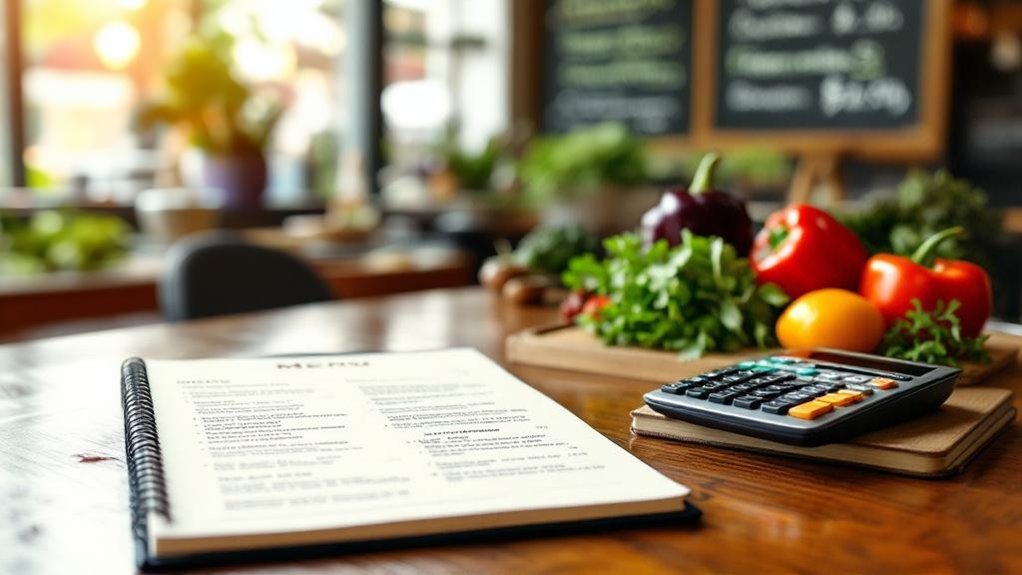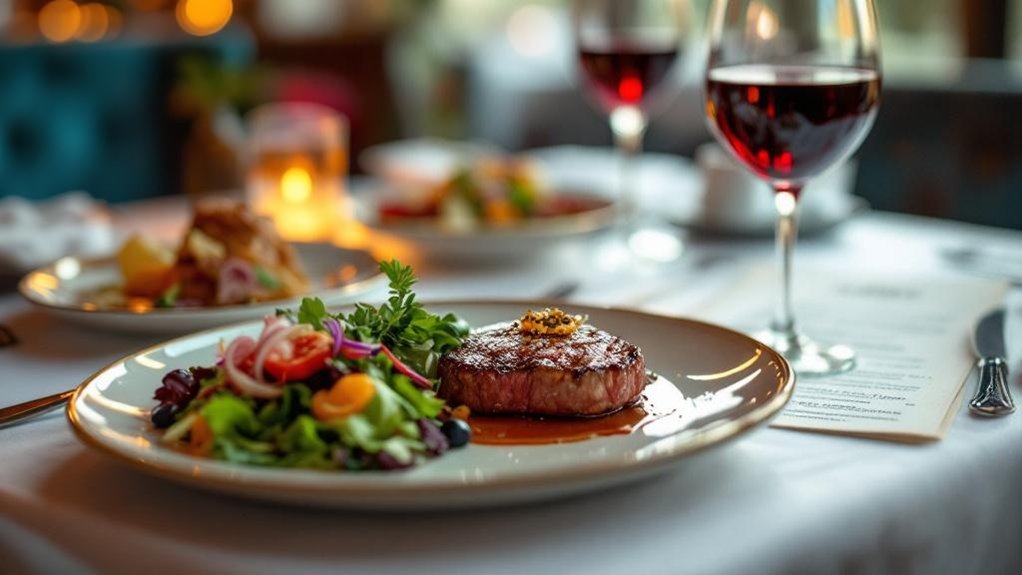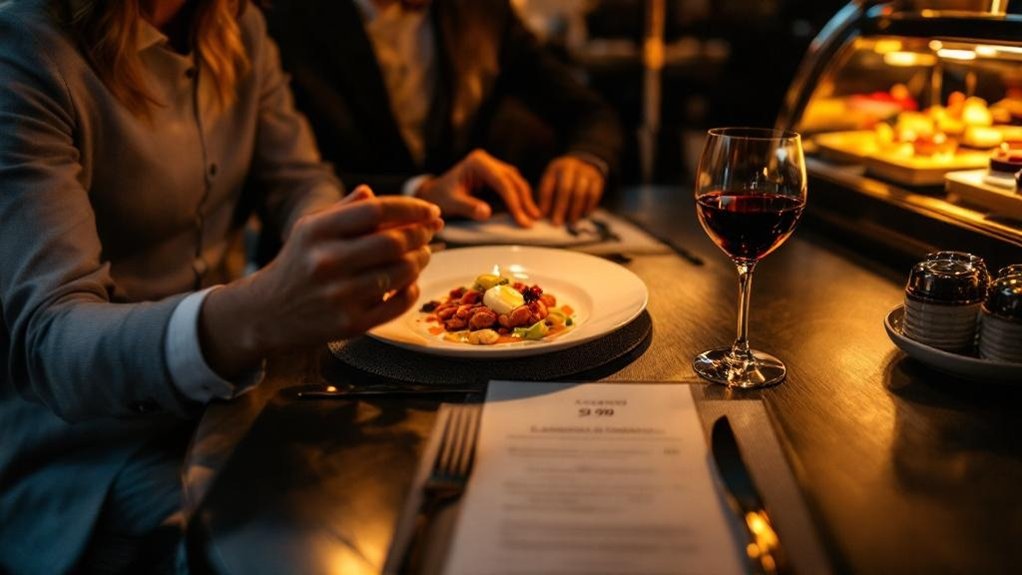To maximize your restaurant's profit margins, start by analyzing food costs to set competitive menu prices. Implement dynamic pricing strategies based on peak demand and consider highlighting high-margin items with enticing descriptions. Bundled meal deals can increase order sizes, and employing psychological pricing techniques can drive sales. By reducing food waste and utilizing seasonal ingredients, you improve cost efficiency. Additionally, guarantee your staff is well-trained in upselling techniques. There’s so much more to explore on enhancing profitability.
Key Takeaways
- Regularly analyze food costs and adjust menu prices to reflect both profitability and perceived value to customers.
- Highlight high-margin items on the menu using enticing descriptions and prime placements to drive sales.
- Implement dynamic pricing strategies to adjust prices based on demand and special events, maximizing revenue during peak times.
- Use bundled deals and meal combinations to encourage larger orders while reducing waste and enhancing customer experience.
- Focus on effective inventory management to minimize spoilage, utilizing FIFO systems and creatively using leftovers.
Analyze Food Costs and Set Menu Prices Accordingly
 .
.
When you plunge into maximizing your restaurant's profit margins, one of the first things you should tackle is analyzing food costs and setting menu prices accordingly. Start by calculating the cost of each ingredient, including waste and spoilage, to understand your true food costs. Then, evaluate your menu items based on their popularity and profitability. It’s essential to strike a balance—don’t just focus on high-margin items; consider customer favorites too. Once you’ve gathered this data, set your prices with both profit and value in mind. Remember, customers are willing to pay more for quality, so make sure your pricing reflects the experience you offer. Regularly revisit your calculations to adapt to changing costs and market trends. Additionally, optimizing your Google My Business listing can enhance your restaurant's visibility, driving more customers to your doors.
Implement Dynamic Pricing Strategies
Dynamic pricing strategies can be a game changer for your restaurant's bottom line. By adjusting prices based on demand, time, and special events, you can optimize revenue while keeping your customers satisfied. For instance, you might raise prices during peak hours or offer discounts during slower times, enticing guests to dine with you when it’s less crowded. Consider leveraging technology like reservation systems that can help analyze customer flow and adjust pricing accordingly. Additionally, you can create limited-time offers that encourage urgency, making customers feel they’re getting a great deal while boosting your profits. Embracing dynamic pricing not only enhances your financial performance but also fosters a sense of excitement around your offerings. Moreover, incorporating family-focused promotions can further attract diverse customer segments during peak times.
Highlight High-Margin Items on the Menu
 .
.
Have you ever considered how much your menu design influences customer choices and your restaurant’s profitability? By highlighting high-margin items, you can steer your patrons toward meals that boost your bottom line. Use descriptive language that evokes flavors and experiences, making these dishes irresistible. Consider placing these items in prime positions—like the top of the menu or within boxes—to draw attention. Additionally, using visuals, such as mouth-watering images, can create a stronger appeal. You might also want to train your staff to recommend these dishes enthusiastically, as their personal touch can make a big difference. By strategically showcasing high-margin items, you not only enhance customer experience but also greatly increase your restaurant's profitability. Furthermore, incorporating high-quality visuals into your menu can significantly elevate the appeal of these dishes and entice more customers to choose them.
Offer Bundled Deals and Meal Combinations
After steering customers toward those high-margin items, consider how bundled deals and meal combinations can further entice them to spend more while enjoying a delightful dining experience. By offering a combination of popular appetizers, entrées, and desserts at a slightly discounted rate, you create an irresistible option for diners. Think about crafting themed bundles, like a taco night or a pasta feast, which not only simplify choices but also enhance the overall experience. You’ll encourage larger orders, as customers perceive they’re getting more value. Plus, these combinations can reduce food waste and streamline your kitchen operations. Ultimately, bundling allows you to showcase your culinary offerings while maximizing profit margins, making it a win-win for both you and your guests. Additionally, implementing loyalty incentives can further enhance customer engagement and encourage repeat visits.
Use Psychological Pricing Techniques
 .
.
When you consider the impact of pricing on consumer behavior, it’s clear that psychological pricing techniques can be a game changer for restaurant profit margins. Using strategies like pricing items at $9.99 instead of $10 creates a perception of value that encourages customers to spend. You can also utilize charm pricing, where prices ending in .99 feel less intimidating and can increase sales. Think about anchoring, too—showing a higher-priced item next to a more affordable one makes the latter seem like a steal. Additionally, offering premium options can elevate the perceived quality of your menu. Remember, it’s not just about numbers; it’s about how those numbers resonate with your diners, influencing their choices and ultimately boosting your bottom line. Incorporating local link building into your marketing strategy can further enhance your restaurant's visibility and profitability.
Regularly Review and Update the Menu
Regularly reviewing and updating your menu is essential not just for keeping your offerings fresh, but for maximizing profit margins as well. Think about it: trends change, and so do customer preferences. By analyzing what sells and what doesn’t, you can identify your star items and phase out those that aren’t pulling their weight. Seasonal ingredients can also enhance your menu, allowing you to capitalize on freshness and potentially lower costs. Plus, updating your menu lets you experiment with pricing strategies, enticing new customers and encouraging repeat visits. Don’t forget to gather feedback from your staff and guests; their insights can be invaluable. Ultimately, a well-curated menu can greatly boost your bottom line and elevate the dining experience. Additionally, consider implementing a rewards structure that aligns with your updated offerings to further engage customers and drive repeat business.
Train Staff on Upselling Techniques
To boost your restaurant's profit margins, training your staff on upselling techniques is a game-changer. When your team knows how to suggest appetizers, desserts, or premium drinks, they create an inviting atmosphere that encourages customers to indulge a little more. Start by educating them on menu highlights and pairing options—this knowledge empowers them to make personalized recommendations. Role-playing scenarios can also help staff practice their delivery, making upselling feel natural rather than forced. Encourage them to read the table and gauge when to introduce these suggestions. Remember, it's not just about increasing the bill; it's about enhancing the dining experience. With the right training, your staff can turn a simple meal into a memorable occasion, benefiting everyone involved. Additionally, leveraging two-way communication helps foster a connection that can lead to increased customer loyalty and upselling opportunities.
Monitor Competitor Pricing and Adjust Accordingly
While it might seem like an intimidating task, keeping an eye on competitor pricing can greatly impact your restaurant's bottom line. By regularly reviewing what similar establishments charge, you can identify trends and adjust your prices accordingly. This isn’t just about undercutting competitors; it’s about finding the sweet spot where your menu aligns with your brand’s value. If you notice a competitor offering a popular dish at a lower price, consider whether you can enhance your offering or justify your price with quality or unique ingredients. Regularly updating your pricing strategy guarantees you remain competitive and attractive to customers. Remember, informed decisions lead to better margins, so don’t shy away from monitoring what others are doing in your market. Additionally, consider how online reviews can influence customer perceptions and overall pricing strategies.
Reduce Food Waste Through Smart Inventory Management
Your restaurant’s success often hinges on its ability to manage resources effectively, and smart inventory management is a game changer when it comes to reducing food waste. Start by tracking your inventory closely; know what you have on hand and what’s nearing its expiration date. Implement a first-in, first-out (FIFO) system to guarantee older stock gets used first. Regularly review your purchase orders and adjust quantities based on customer demand, avoiding over-ordering. Train your staff to handle food properly to minimize spoilage and establish a clear plan for utilizing leftovers creatively. By being proactive about your inventory, you not only cut down on waste but also save money, ultimately boosting your profit margins while promoting sustainability in your restaurant. Moreover, focusing on employee retention strategies can help ensure that your staff is well-trained and motivated to uphold these practices effectively.
Utilize Seasonal Ingredients for Cost Efficiency
Embracing seasonal ingredients not only enhances your menu's appeal but also greatly boosts your cost efficiency. When you source produce that's in-season, you're tapping into fresher flavors while often reducing costs. Local farmers typically offer better prices for ingredients that are abundant, which helps keep your food costs low. Plus, seasonal items allow you to creatively adapt your menu, enticing regulars to return for new dishes. You also reduce the risk of spoilage, as these ingredients have a shorter supply chain. Think about crafting specials that highlight these seasonal gems; it creates excitement and can drive sales. Ultimately, prioritizing seasonal ingredients isn’t just a smart business move; it’s also an opportunity to showcase your commitment to quality and sustainability. Additionally, leveraging high-quality visuals can enhance the appeal of your seasonal dishes on social media, attracting even more customers to your restaurant.
Frequently Asked Questions
How Can Customer Feedback Affect Restaurant Pricing Strategies?
Customer feedback can greatly shape your restaurant’s pricing strategies. When patrons express their thoughts on menu items, you gain insights into perceived value, allowing you to adjust prices accordingly. If diners rave about a dish, you might consider increasing its price, confident in its popularity. Conversely, consistent complaints may signal a need for a price drop or recipe tweak. Listening closely to your customers helps you strike that perfect balance between quality and cost.
What Role Does Location Play in Restaurant Profit Margins?
Location's essential for your restaurant’s profit margins. A prime spot can attract more foot traffic, leading to higher sales. Think about visibility, accessibility, and nearby competition. If you’re in a bustling area, you can often charge more, capitalizing on demand. Conversely, a less desirable location might force you to lower prices to draw customers in. Ultimately, your choice of location directly influences your customer base, pricing strategy, and overall profitability.
How Can Social Media Impact Restaurant Sales and Profits?
Social media can greatly boost your restaurant's sales and profits. By showcasing mouth-watering dishes and engaging with your audience, you create a community around your brand. Regular updates keep customers informed about specials, events, and promotions, driving foot traffic. User-generated content, like customer photos, acts as authentic endorsements, enhancing your credibility. Plus, social media ads can target specific demographics, increasing visibility. Ultimately, it’s about building relationships and creating excitement around your offerings.
What Are the Benefits of Loyalty Programs for Profit Margins?
Loyalty programs can greatly boost your restaurant's profit margins. By encouraging repeat visits, you create a steady revenue stream. Customers feel valued, fostering a sense of community and enhancing their overall experience. These programs also provide valuable data on preferences, helping you tailor offerings and optimize inventory. Plus, they often lead to increased spending per visit, as loyal patrons are more likely to try new dishes or indulge in extras.
How Often Should Restaurants Conduct Market Research for Pricing?
You should conduct market research at least twice a year to stay competitive. This regular check-in helps you understand pricing trends, customer preferences, and what your competitors are doing. When you gather this data, you can adjust your menu prices strategically, ensuring you're meeting customer expectations while maximizing your profit potential. Remember, markets are always changing, and staying informed means you won't get left behind. Regular research keeps your pricing relevant and effective.




